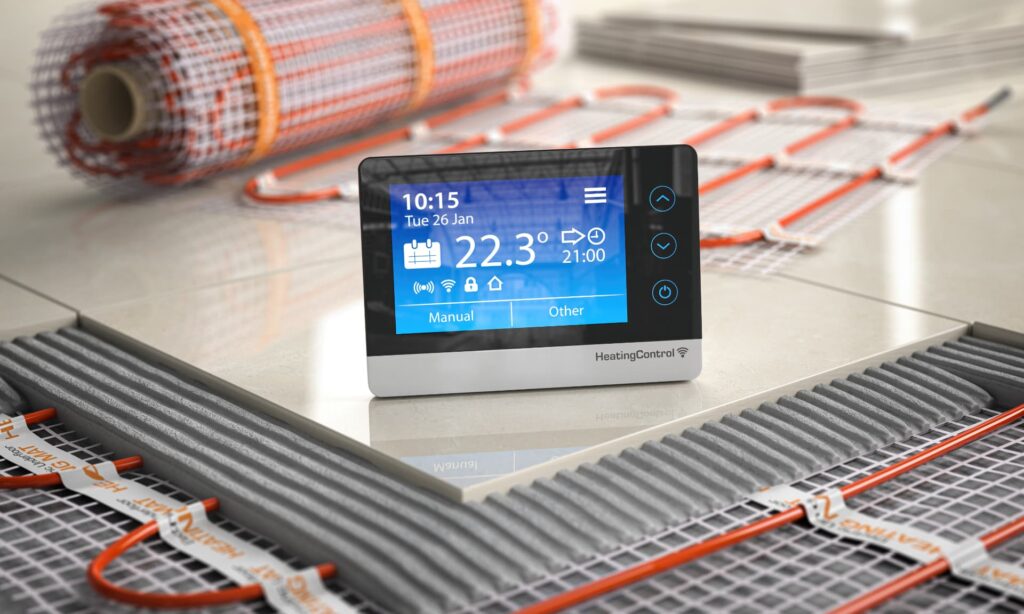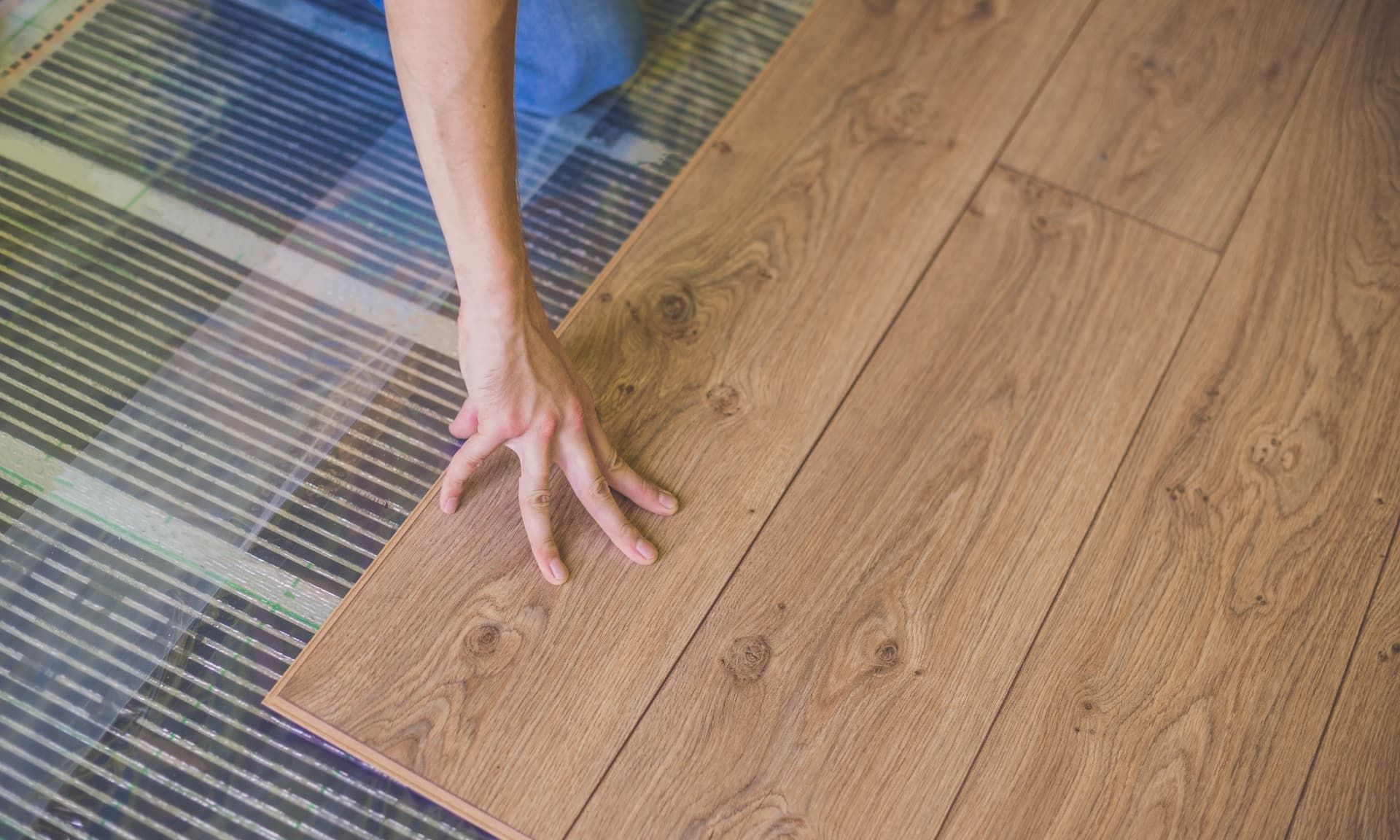For a garden room to be a functional space throughout the year, heating is a must. In fact, most suppliers will include some form of heating as standard. Still, there are plenty of options to choose from, and one of the most luxurious ways to heat a garden room is underfloor heating.
With no radiators in sight, underfloor heating helps preserve the floor space you’ve created in your new garden room or office. Furthermore, it distributes heat evenly, avoiding cold spots.
In this article, we’ll cover everything you need to know about underfloor heating, including the options available, how much it costs to install, and whether it’s worth it.
Table of Contents
How underfloor heating works
An underfloor heating system (UFH) essentially turns the floor of your garden room into a radiator. While UFH transfers some heat via conduction and convection, the primary transfer method is thermal radiation.
Radiant heat uses electromagnetic waves to heat the people and objects in a room directly. Infrared radiation will travel until absorbed by an object which heats up in turn. Although that may sound disconcerting, keep in mind that each of us experiences radiant heat in everyday life. The most commonly cited example is the sun. Even on a freezing cold day, you can still feel the warmth of the sun when it shines on your skin.
A typical wall mounted radiator, by contrast, primarily uses convection to heat a room. When a radiator heats the surrounding air, it rises and eventually falls as it cools, creating a cycle. The further away you go from the heat source, the colder it gets.
Benefits of using underfloor heating in a garden office
Floor Space
When we’re visualising how we’re going to use the newly created space in our garden room or office, we don’t tend to give much thought to radiators. It’s easy to underestimate the role they play in how we arrange our furniture. Not only do they occupy wall space, but they also limit the floor space around them. Underfloor heating removes the obstacle entirely and helps maximise the space.
Heat Distribution
The even distribution of heat produced by underfloor heating leads to a relatively consistent temperature throughout the room.
More traditional convection based options rely on a loop created by the rising and falling temperature of the air. Naturally, that means that the further away you are from the radiator, the colder it feels.
Warm Underfoot
Some of the most popular floor coverings for garden rooms include laminate, hardwood, and tile. All three categories share a commonality: the need for shoes or slippers on a cold day.
Underfloor heating raises the floor surface to a toasty temperature, regardless of floor covering.
Disadvantages of underfloor heating
Upfront Cost
Underfloor heating can have a high upfront cost like a wood burning stove, which is unlikely to be offset by any efficiency savings. We’ll dive more into both installation and running costs below.
Responsiveness
Responsiveness impacts UFH in two ways. Firstly, the length of time it takes to warm up. An electric system typically takes 30 minutes to an hour to fully warm up, but it’ll vary based on your subfloor. Then there’s the length of time it takes for the floor to cool down after it has been switched off.
The lack of responsiveness makes it better suited to rooms occupied for extended periods, such as a garden office.
Is underfloor heating sufficient to keep a garden room warm?
We’ve seen many articles which mistakenly refer to underfloor heating as a secondary heat source, complimentary to an oil-filled radiator or similar.
Underfloor heating is more than capable of being the sole source of heat in a well-insulated garden room.
Arguably, adding another heat source would defeat its purpose. You’d lose out on benefits such as preserving floor space and almost certainly overheat the room.
You need to match the size of the system you buy to the space you want to heat.
Types of underfloor heating
While there are two main categories of underfloor heating, hydronic (wet) and electric (dry), the latter is the most suitable for a garden room setting.
Wet / hydronic underfloor heating

A wet system circulates hot water through a series of pipes laid just below the floor’s surface. A hydronic setup needs to be connected to a boiler or heat pump, making it impractical for most garden rooms. As such, the focus of this article is on the other type of underfloor heating, electric.
Dry / electric underfloor heating
Electric underfloor heating uses an array of thin wires, either loose or pre-arranged in a mat. Mats are quicker and more convenient to install, making them ideal for most garden rooms. On the other hand, loose wiring is used for more awkwardly shaped rooms where a mat may be less practical.

A thin piece of insulation, intended to help direct heat upwards, replaces regular flooring underlay. Then the wiring or mat is laid, with the floor covering going immediately above.
Electric underfloor heating systems vary based on wattage and tend to range from 100W to 200W per square metre.
How powerful does underfloor heating need to be for a garden room?
The power of an electric underfloor heating system is measured in watts per square metre. Many manufacturers will offer a choice of 100W/m², 150W/m², and 200W/m².
The system you buy must be powerful enough to heat the room, or you’ll find yourself supplementing it with another heater. Fortunately, even 100W/m² should be more than adequate for most insulated garden rooms.
The thing to keep in mind is how much of the floor area will be underlaid with heating wires. If you’re only covering a small area, it’ll have to work harder to heat the room. For example, in a bathroom, you’d have to account for fixtures like the bath. You should expect pretty much full coverage in a garden room; however, awkward shapes can present a challenge.
Can an electric underfloor heating system be overpowered?
So, underpowered is a problem. But what about overpowered? Is there such a thing?
A 100W electric underfloor heating system and a 200W system will use the same amount of power once the room has warmed up. If the room demands 80W/m² of heating, that’s roughly what both systems will supply. Surprisingly, the difference isn’t ongoing consumption but rather responsiveness. A 200W system will warm the room to its desired temperature faster than a less powerful system.
Since responsiveness can be one of the drawbacks to UFH, anything that can reduce heat up time is welcome.
How much does it cost to install underfloor heating in a garden room?
When calculating the cost of installing underfloor heating in a garden room, you need to consider both materials and labour.
At the lower end of the market, a DIY heat mat kit can cost as little as £25/m² including VAT. Consider that it’s challenging to go back and make changes once you lay over the floor. More typically, you should expect to be paying anywhere from £40 to £85 per square metre for materials in a professional installation.
If you’re buying the kit yourself, be sure to check whether it includes a layer of thin insulation. While the floor of your garden room is already insulated, you’ll still want a continuous break between the timber floor and the heat mat to improve efficiency. It’s certainly possible to lay electric underfloor heating yourself, but you’ll need a qualified electrician to connect it up.
Another factor that impacts the cost of materials is the type of thermostat you choose. We’ll expand more on thermostats in the section on controlling underfloor heating.
Once you factor in labour cost, many garden room suppliers charge between £65 and £110 (ex. VAT) per square metre for an underfloor heating system. A standard 4m x 3m garden room will have an internal floor area of roughly 10.5m². For a room that size, you could expect to pay around £820 to £1,385 including VAT.
Is underfloor heating expensive to run?
Underfloor heating takes between 30 minutes and an hour to warm up and stays warm for a long time after being switched off. As such, it’s most economical in garden rooms used for an extended period of time.
Underfloor heating tends to be thought of as an efficient way to heat a room. That can be quite misleading, though. Firstly, there are two types of underfloor heating, and it’s often wet systems that are economical to run. Secondly, there’s a big difference between cost-efficient and energy-efficient.
All forms of electric heating are 100% efficient, meaning that all the electricity you put in is output as heat. By contrast, a wet system is often paired with a far less energy-efficient gas boiler. Even so, it’s still considerably cheaper to run, thanks to the much lower unit price of gas.
Electric underfloor heating could be cheaper to run than a panel heater because of its performance characteristics and how thermal comfort is perceived. In reality, though, the difference probably isn’t too substantial.
Will underfloor heating raise my floor?
You may be wondering if adding a heating element beneath your floor will impact your overall ceiling height. After all, garden rooms built under permitted development already have lower ceilings than a standard British home.
An electric underfloor heating setup will have a negligible impact on floor height. It will vary depending on the supplier, but the entire system, including insulation, will often add less than 7mm to the floor height. Keep in mind that the insulation layer replaces underlay, so the impact is even less.
While unlikely to be used in a garden room environment, wet setups would meaningfully impact floor height.
How to control underfloor heating
A thermostat controls electric underfloor heating in much the same way as a regular heating system. UFH suppliers will often have multiple models to choose from with varying features.

Given the points already made on responsiveness, make sure the thermostat you choose offers a lot of scheduling control. Ideally, you should have complete control over the week rather than just a single day. Most garden rooms are set between 19°C and 21°C.
In 2022, as smart home tech becomes ubiquitous, plenty of WiFi-connected thermostats are available. Being able to control your garden office heating from your phone is a nice feature to have, even if it’s something you’ll only change infrequently. It’s great to be able to switch the heating on remotely ahead of an impromptu visit on a winter day.
Can underfloor heating be retrofitted in a garden room?
Has your garden room already been built? Maybe you’re sitting in there right now asking yourself whether it’s too late. Well, the good news is retrofitting is undoubtedly possible. It’s always easier to install beforehand, though.
To retrofit underfloor heating, you’ll need to lift your existing floor. How simple (and destructive) it’s going to be will depend upon your chosen floor covering. Carpet, for instance, would be pretty straightforward. Laminate may well be tedious, but it’s still feasible without breaking the floor in many cases. Tile is another story entirely.
Summary – is underfloor heating in a garden room worth it?
If you want a garden room that feels luxurious, underfloor heating can be a fantastic choice. Even tiled floors will feel warm and toasty underfoot on the coldest of days. By freeing up the floor space of radiators, you’ll have more flexibility in positioning furniture, which helps get the most out of your room.
If you’re looking to reduce energy bills, on the other hand, electric underfloor heating probably isn’t the answer. All forms of electric heating are 100% efficient. The way heat is perceived may be different, but input costs are likely the same as any other electric heating. Even if there is a cost-saving, it’s unlikely to offset the upfront investment.


